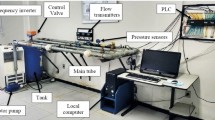Abstract
Fermentation process is a time-varying, nonlinear and multivariable dynamic coupling system. Therefore, it is difficult to directly measure the key biological variables using traditional physical sensors during the process of fermentation, which makes the monitoring and real-time control impossible. To resolve this problem, a data-driven soft sensor modeling method based on deep neural network (DNN) is proposed in this paper. This method is suitable for large amount of data and it enjoys high efficiency and robustness. At the same time, an adaptive moment estimation (Adam) algorithm is used to optimize the hyper-parameters of the DNN model, which is a technique for efficient stochastic optimization that only requires first-order gradients with little memory requirement. The consistent correlation method is used to determine the auxiliary variables of the soft sensor model. The penicillin and l-lysine fermentation processes are taken as the research object, substrate concentration, cell concentration, and product concentration are selected as a target variable. The performance of established soft sensor model is evaluated through the indexes of mean square error (MSE), root-mean-square error (RMSE), and mean absolute error (MAE). The simulation results show that the prediction performance of the soft sensor model based on DNN-Adam is good and compared with model based on stochastic gradient descent (SGD) with momentum optimization algorithm. It is verified that the proposed method can make a more accurate real-time prediction of quality variables in the fermentation process, and it has higher prediction accuracy than DNN-SGD method.








Similar content being viewed by others
References
Kadlec P, Gabrys B, Strandt S. Data-driven soft sensors in the process industry. Comput Chem Eng. 2009;33(4):795–814.
Chéruy A. Software sensors in bioprocess engineering. J Biotechnol. 1997;52(3):193–9.
Luttmann R, Bracewell DG, Cornelissen G, Gernaey KV, Glassey J, Hass VC, Kaiser C, Preusse C, Striedner G, Mandenius CF. Soft sensors in bioprocessing: a status report and recommendations. Biotechnol J. 2012;7(8):1040–8.
Randek J, Mandenius C-F. On-line soft sensing in upstream bioprocessing. Crit Rev Biotechnol. 2018;38(1):106–21.
Zhu X, Rehman KU, Wang B, Shahzad M. Modern soft-sensing modeling methods for fermentation processes. Sensors. 2020;20(6):1771.
Nasr N, Hafez H, El Naggar MH, Nakhla G. Application of artificial neural networks for modeling of biohydrogen production. Int J Hydrogen Energy. 2013;38(8):3189–95.
Sivapathasekaran C, Sen R. Performance evaluation of an ANN–GA aided experimental modeling and optimization procedure for enhanced synthesis of marine biosurfactant in a stirred tank reactor. J Chem Technol Biotechnol. 2013;88(5):794–9.
Cortes C, Vapnik V. Support-vector networks. Mach Learn. 1995;20(3):273–97.
Wang B, Sun Y, Ji X, Huang Y, Ji L, Huang L. Soft-sensor modeling for lysine fermentation processes based on PSO-SVM inversion. CIESC J. 2012;63(9):3000–7.
Gu Y, Zhao W, Wu Z. Least squares support vector machine algorithm [J]. J Tsinghua Univ (Sci Technol). 2010;7:1063–6.
Ou Yang H-B, Li S, Zhang P, Kong X. Model penicillin fermentation by least squares support vector machine with tuning based on amended harmony search. Int J Biomath. 2015;8(03):1550037.
Kresta J, Marlin T, MacGregor J. Development of inferential process models using PLS. Comput Chem Eng. 1994;18(7):597–611.
Krizhevsky A, Sutskever I, Hinton GE. Imagenet classification with deep convolutional neural networks. In: Advances in neural information processing systems, 2012. pp 1097–1105
Mikolov T, Chen K, Corrado G, Dean J. Efficient estimation of word representations in vector space. arXiv preprint; 2013. arXiv:1301.3781
Qian N. On the momentum term in gradient descent learning algorithms. Neural Networks. 1999;12(1):145–51.
Sutton R. Two problems with back propagation and other steepest descent learning procedures for networks. In: Proceedings of the Eighth Annual Conference of the Cognitive Science Society, 1986, 1986. pp 823–832
Tieleman T, Hinton G. Lecture 6.5-rmsprop, coursera: Neural networks for machine learning. University of Toronto, Technical Report; 2012
Kingma DP, Ba J. Adam: A method for stochastic optimization. arXiv preprint; 2014. arXiv:1412.6980
Lin Y, Yan W Study of soft sensor modeling based on deep learning. In: 2015 American Control Conference (ACC), 2015. IEEE, pp 5830–5835
Hinton GE, Osindero S, Teh Y-W. A fast learning algorithm for deep belief nets. Neural Comput. 2006;18(7):1527–54.
Hornik K. Approximation capabilities of multilayer feedforward networks. Neural Networks. 1991;4(2):251–7.
Plaut D, Nowlan S, Hinton G. Experiments on learning by back propagation. Computer Science Department Carnegie-Mellon University Pittsburgh; 1986.
Chollet F. Deep learning mit Python und Keras: Das Praxis-Handbuch vom Entwickler der Keras-Bibliothek. Wachtendonk: MITP-Verlags GmbH & Co; 2018.
Wang B, Shahzad M, Zhu X, Rehman KU, Uddin S. A non-linear model predictive control based on grey-wolf optimization using least-square support vector machine for product concentrationcontrol in l-lysine fermentation. Sensors. 2020;20:3335.
Wang B, Shahzad M, Zhu X, et al. Soft-sensor modeling for L-lysine fermentation process based on hybrid ICS-MLSSVM. Sci Rep. 2020;10:11630.
Acknowledgements
The National Science Research Foundation of China (41376175), The Natural Science Foundation of Jiangsu Province (BK20140568, BK20151345), and a project funded by the priority academic program development of Jiangsu higher education institutions (PAPD).
Author information
Authors and Affiliations
Corresponding author
Ethics declarations
Conflict of Interest
The authors declare that they have no conflict of interest.
Additional information
Publisher's Note
Springer Nature remains neutral with regard to jurisdictional claims in published maps and institutional affiliations.
Rights and permissions
About this article
Cite this article
Zhu, X., Rehman, K.U., Bo, W. et al. Data-Driven Soft Sensor Model Based on Deep Learning for Quality Prediction of Industrial Processes. SN COMPUT. SCI. 2, 40 (2021). https://doi.org/10.1007/s42979-020-00440-4
Received:
Accepted:
Published:
DOI: https://doi.org/10.1007/s42979-020-00440-4



